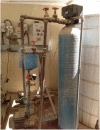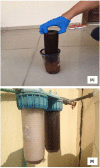Influence of Household Water Filters on Bacteria Growth and Trace Metals in Tap Water of Doha, Qatar
- PMID: 29844504
- PMCID: PMC5974232
- DOI: 10.1038/s41598-018-26529-8
Influence of Household Water Filters on Bacteria Growth and Trace Metals in Tap Water of Doha, Qatar
Abstract
Deteriorating water quality from aging infrastructure, growing threat of pollution from industrialization and urbanization, and increasing awareness about waterborne diseases are among the factors driving the surge in worldwide use of point-of-entry (POE) and point-of-use (POU) filters. Any adverse influence of such consumer point-of-use systems on quality of water at the tap remains poorly understood, however. We determined the chemical and microbiological changes in municipal water from the point of entry into the household plumbing system until it leaves from the tap in houses equipped with filters. We show that POE/POU devices can induce significant deterioration of the quality of tap water by functioning as traps and reservoirs for sludge, scale, rust, algae or slime deposits which promote microbial growth and biofilm formation in the household water distribution system. With changes in water pressure and physical or chemical disturbance of the plumbing system, the microorganisms and contaminants may be flushed into the tap water. Such changes in quality of household water carry a potential health risk which calls for some introspection in widespread deployment of POE/POU filters in water distribution systems.
Conflict of interest statement
The authors declare no competing interests.
Figures





Similar articles
-
Microbiological contamination of drinking water in a commercial household water filter system.Eur J Clin Microbiol Infect Dis. 1996 Mar;15(3):233-7. doi: 10.1007/BF01591360. Eur J Clin Microbiol Infect Dis. 1996. PMID: 8740859
-
Chemical and microbial characteristics of municipal drinking water supply systems in the Canadian Arctic.Environ Sci Pollut Res Int. 2018 Nov;25(33):32926-32937. doi: 10.1007/s11356-017-9423-5. Epub 2017 Jun 13. Environ Sci Pollut Res Int. 2018. PMID: 28612312
-
Efficacy and Effectiveness of Showerheads Attached with Point-of-use (POU) Filter Capsules in Preventing Waterborne Diseases in a Japanese Hospital.Biocontrol Sci. 2020;25(4):223-230. doi: 10.4265/bio.25.223. Biocontrol Sci. 2020. PMID: 33281180
-
Desalinated drinking water in the GCC countries - The need to address consumer perceptions.Environ Res. 2017 Oct;158:203-211. doi: 10.1016/j.envres.2017.06.018. Epub 2017 Jun 23. Environ Res. 2017. PMID: 28651147 Review.
-
Risk of waterborne illness via drinking water in the United States.Rev Environ Contam Toxicol. 2008;192:117-58. doi: 10.1007/978-0-387-71724-1_4. Rev Environ Contam Toxicol. 2008. PMID: 18020305 Free PMC article. Review.
Cited by
-
A comprehensive risk assessment of toxic elements in international brands of face foundation powders.Environ Res. 2021 Jan;192:110274. doi: 10.1016/j.envres.2020.110274. Epub 2020 Oct 8. Environ Res. 2021. PMID: 33038363 Free PMC article.
-
A heavy metal baseline score predicts outcome in acute myeloid leukemia.Am J Hematol. 2020 Apr;95(4):422-434. doi: 10.1002/ajh.25731. Epub 2020 Mar 4. Am J Hematol. 2020. PMID: 31944361 Free PMC article.
-
Influence of phosphate on bacterial release from activated carbon point-of-use filters and on biofilm characteristics.Sci Total Environ. 2024 Mar 1;914:169932. doi: 10.1016/j.scitotenv.2024.169932. Epub 2024 Jan 8. Sci Total Environ. 2024. PMID: 38199359 Free PMC article.
-
Metagenomic analysis of an urban resistome before and after wastewater treatment.Sci Rep. 2020 May 18;10(1):8174. doi: 10.1038/s41598-020-65031-y. Sci Rep. 2020. PMID: 32424207 Free PMC article.
-
The assessment of cadmium, chromium, copper, and nickel tolerance and bioaccumulation by shrub plant Tetraena qataranse.Sci Rep. 2019 Apr 4;9(1):5658. doi: 10.1038/s41598-019-42029-9. Sci Rep. 2019. PMID: 30948781 Free PMC article.
References
-
- Cotruvo JA, Andrew R, Herman R. Point of Use and Point of Entry Treatment Technologies Applicable in the Home for Controlling Chemical, Microbial, and Aesthetic Contaminants in Drinking Water. Comprehensive Water Quality and Purification. Elsevier, Amsterdam. 2014;2:196–211. doi: 10.1016/B978-0-12-382182-9.00034-7. - DOI
-
- WHO. Desalination. Rolling revision of the WHO Guidelines for Drinking Water Quality, Available at (17 January 2018): http://www.who.int/water_sanitation_health/gdwqrevision/desalination/en/ (2010).
-
- US EPA. Investigation of the Capability of Point-of-Use/Point-of-Entry Treatment Devices as a Means of Providing Water Security. U.S. Environmental Protection Agency, Office of Research and Development, National Homeland Security Research Center, Cincinnati, OH, USA (2006).
Publication types
MeSH terms
Substances
Grants and funding
LinkOut - more resources
Full Text Sources
Other Literature Sources
Medical
Miscellaneous

